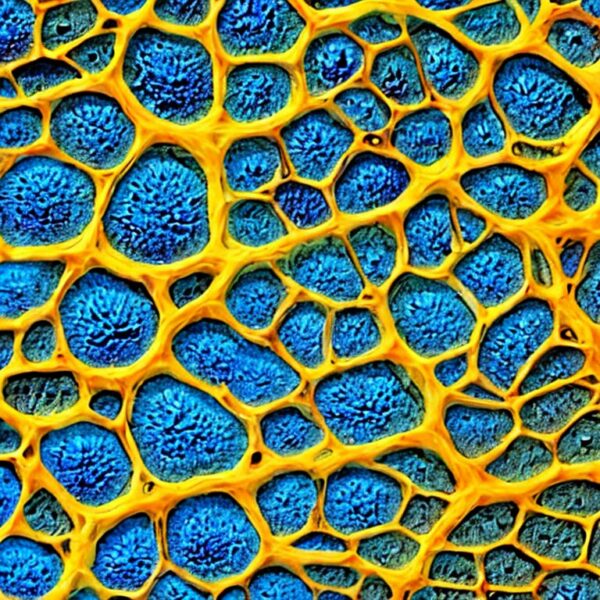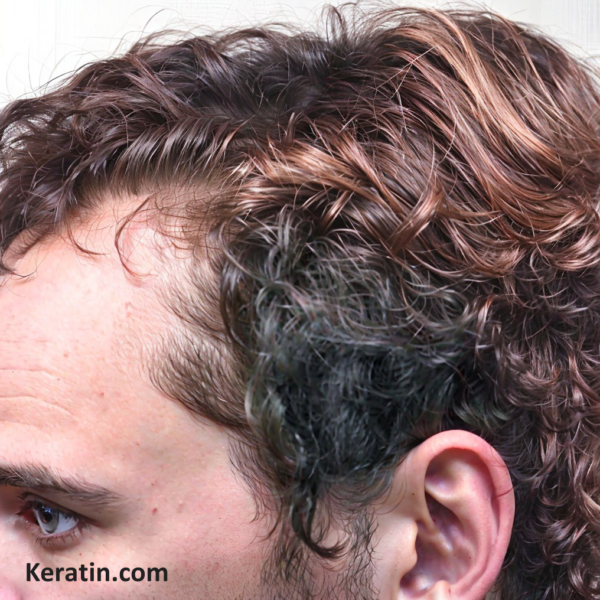Title: The Role of Integrins in Androgenetic Alopecia: A Comprehensive Review
Androgenetic alopecia (AGA) is a common form of hair loss that affects both men and women, characterized by a progressive thinning of the hair on the scalp. The pathogenesis of AGA is multifactorial, involving genetic predisposition, hormonal influences, and age. Recent research has highlighted the potential role of integrins, a family of cell adhesion molecules, in the development and progression of AGA.
Integrins are transmembrane receptors, expressed on the surface of cells, that facilitate cell-extracellular matrix (ECM) adhesions, playing crucial roles in various biological processes including cell proliferation, differentiation, and migration. In the context of AGA, integrins are believed to mediate the interactions between dermal papilla cells and ECM. These interactions are believed to be critical for hair follicle cycling and hair shaft production.
A research article from 2011 indicates that integrin, α6 (ITGA6) can be found on keratinocyte stem cells in hair follicles. However, this integrin, along with the number of stem cells in hair follicles, is much reduced during the development of pattern hair loss. The scientists suggested that the findings supported the idea that there is a defect in the conversion of hair follicle stem cells to progenitor cells during hair growth and that this plays a role in the pathogenesis of AGA.
A recent study titled “Targeting integrin pathways: mechanisms and advances in therapy” provides a comprehensive overview of the role of integrins in various diseases, including AGA. The study highlights the potential of integrin-targeted therapies in treating AGA, suggesting that modulating integrin signaling could help to restore normal hair growth in individuals with AGA. Another article from 2023 lists drug AS-101, a drug that targets several integrins, as being in clinical trials for female androgenetic alopecia. Though no results have been published thus far.
A further study titled “The medicinal activity of lyophilized aqueous seed extract of Lepidium sativum in an androgenic alopecia model” provides further insights into the role of integrins in AGA. The study found that Lepidium sativum seed extract (LSLE), a traditional remedy for hair loss, could promote hair growth in a rat model of AGA. The researchers suggested that the beneficial effects of LSLE might be due to a variety of actions, but also attributed to its ability to modulate integrin signaling in hair follicles.
In the study, LSLE was found to increase the levels of several growth factors, including vascular endothelial growth factor (VEGF), connective tissue growth factor (CTGF), and fibroblast growth factor (FGF), which are known to promote hair growth. These growth factors are believed to enhance the interactions between dermal papilla cells and ECM via integrin signaling, thereby stimulating hair follicle cycling and hair shaft production.
Moreover, the study demonstrated that LSLE could inhibit the activity of 5-alpha reductase, an enzyme that converts testosterone to dihydrotestosterone (DHT). DHT is a potent androgen that has been implicated in the pathogenesis of AGA, as it can bind to androgen receptors on the hair follicles and trigger a series of events leading to hair follicle miniaturization.
There has not been a concerted effort to investigate the role of integrins in pattern hair loss. However, the findings of these studies suggest that integrin signaling could play a significant role in the pathogenesis of AGA and could be a promising target for AGA treatment. By modulating integrin signaling, it might be possible to restore normal hair growth in individuals with AGA. However, further research is needed to fully elucidate the role of integrins in AGA and to develop effective integrin-targeted therapies for this condition.
In conclusion, the role of integrins in AGA is a burgeoning area of research that holds promise for the development of novel therapeutic strategies. By deepening our understanding of the molecular mechanisms underlying AGA, we can pave the way for the development of more effective treatments for this common and distressing condition.
Bibliography
11711645 {11711645:PPFKDPXZ},{11711645:PJNXBS3F},{11711645:MZ9XEUWV},{11711645:C8XK77E5},{11711645:R2FCIQQF},{11711645:SZKQCZS3} 1 vancouver 50 date asc 118 https://www.keratin.com/wp-content/plugins/zotpress/ %7B%22status%22%3A%22success%22%2C%22updateneeded%22%3Afalse%2C%22instance%22%3Afalse%2C%22meta%22%3A%7B%22request_last%22%3A0%2C%22request_next%22%3A0%2C%22used_cache%22%3Atrue%7D%2C%22data%22%3A%5B%7B%22key%22%3A%22PJNXBS3F%22%2C%22library%22%3A%7B%22id%22%3A11711645%7D%2C%22meta%22%3A%7B%22creatorSummary%22%3A%22Sredni%20et%20al.%22%2C%22parsedDate%22%3A%222004-02%22%2C%22numChildren%22%3A0%7D%2C%22bib%22%3A%22%26lt%3Bdiv%20class%3D%26quot%3Bcsl-bib-body%26quot%3B%20style%3D%26quot%3Bline-height%3A%201.35%3B%20%26quot%3B%26gt%3B%5Cn%20%20%26lt%3Bdiv%20class%3D%26quot%3Bcsl-entry%26quot%3B%20style%3D%26quot%3Bclear%3A%20left%3B%20%26quot%3B%26gt%3B%5Cn%20%20%20%20%26lt%3Bdiv%20class%3D%26quot%3Bcsl-left-margin%26quot%3B%20style%3D%26quot%3Bfloat%3A%20left%3B%20padding-right%3A%200.5em%3B%20text-align%3A%20right%3B%20width%3A%201em%3B%26quot%3B%26gt%3B1.%26lt%3B%5C%2Fdiv%26gt%3B%26lt%3Bdiv%20class%3D%26quot%3Bcsl-right-inline%26quot%3B%20style%3D%26quot%3Bmargin%3A%200%20.4em%200%201.5em%3B%26quot%3B%26gt%3BSredni%20B%2C%20Gal%20R%2C%20Cohen%20IJ%2C%20Dazard%20JE%2C%20Givol%20D%2C%20Gafter%20U%2C%20et%20al.%20Hair%20growth%20induction%20by%20the%20Tellurium%20immunomodulator%20AS101%3A%20association%20with%20delayed%20terminal%20differentiation%20of%20follicular%20keratinocytes%20and%20ras-dependent%20up-regulation%20of%20KGF%20expression.%20FASEB%20J.%202004%20Feb%3B18%282%29%3A400%26%23x2013%3B2.%26lt%3B%5C%2Fdiv%26gt%3B%5Cn%20%20%20%26lt%3B%5C%2Fdiv%26gt%3B%5Cn%26lt%3B%5C%2Fdiv%26gt%3B%22%2C%22data%22%3A%7B%22itemType%22%3A%22journalArticle%22%2C%22title%22%3A%22Hair%20growth%20induction%20by%20the%20Tellurium%20immunomodulator%20AS101%3A%20association%20with%20delayed%20terminal%20differentiation%20of%20follicular%20keratinocytes%20and%20ras-dependent%20up-regulation%20of%20KGF%20expression%22%2C%22creators%22%3A%5B%7B%22creatorType%22%3A%22author%22%2C%22firstName%22%3A%22Benjamin%22%2C%22lastName%22%3A%22Sredni%22%7D%2C%7B%22creatorType%22%3A%22author%22%2C%22firstName%22%3A%22Rivka%22%2C%22lastName%22%3A%22Gal%22%7D%2C%7B%22creatorType%22%3A%22author%22%2C%22firstName%22%3A%22Ian%20J.%22%2C%22lastName%22%3A%22Cohen%22%7D%2C%7B%22creatorType%22%3A%22author%22%2C%22firstName%22%3A%22Jean-Eudes%22%2C%22lastName%22%3A%22Dazard%22%7D%2C%7B%22creatorType%22%3A%22author%22%2C%22firstName%22%3A%22David%22%2C%22lastName%22%3A%22Givol%22%7D%2C%7B%22creatorType%22%3A%22author%22%2C%22firstName%22%3A%22Uzi%22%2C%22lastName%22%3A%22Gafter%22%7D%2C%7B%22creatorType%22%3A%22author%22%2C%22firstName%22%3A%22Benny%22%2C%22lastName%22%3A%22Motro%22%7D%2C%7B%22creatorType%22%3A%22author%22%2C%22firstName%22%3A%22Siona%22%2C%22lastName%22%3A%22Eliyahu%22%7D%2C%7B%22creatorType%22%3A%22author%22%2C%22firstName%22%3A%22Michael%22%2C%22lastName%22%3A%22Albeck%22%7D%2C%7B%22creatorType%22%3A%22author%22%2C%22firstName%22%3A%22Harry%20M.%22%2C%22lastName%22%3A%22Lander%22%7D%2C%7B%22creatorType%22%3A%22author%22%2C%22firstName%22%3A%22Yona%22%2C%22lastName%22%3A%22Kalechman%22%7D%5D%2C%22abstractNote%22%3A%22The%20synthetic%20immunomodulator%20AS101%5Bammonium%20trichloro%28dioxoethylene-o%2Co%26%23039%3B%29tellurate%5D%20was%20previously%20found%20to%20protect%20cancer%20patients%20from%20chemotherapy-induced%20bone%20marrow%20toxicity%20and%20alopecia.%20Here%20we%20show%20that%20AS101%20induces%20hair%20growth%20in%20nude%20and%20normal%20mice.%20AS101%20possesses%20the%20dual%20ability%20to%20both%20induce%20anagen%20and%20retard%20spontaneous%20catagen%20in%20the%20C57BL%5C%2F6%20mouse%20model.%20Anagen%20induced%20by%20AS101%20is%20mediated%20by%20keratinocyte%20growth%20factor%20%28KGF%29%2C%20as%20it%20is%20abrogated%20both%20in%20nude%20mice%20co-treated%20with%20AS101%20plus%20neutralizing%20anti%20KGF%20antibodies%20and%20in%20AS101-treated%20transgenic%20mice%20expressing%20a%20dominant-negative%20KGF%20receptor%20transgene%20in%20basal%20keratinocytes.%20AS101%20up-regulates%20KGF%20expression%20by%20activating%20the%20ras%20signaling%20pathway%20in%20cultured%20fibroblasts.%20AS101-induced%20delayed%20catagen%20is%20associated%20with%20inhibition%20of%20terminal%20differentiation%20marker%20expression%20both%20in%20nude%20and%20C57BL%5C%2F6%20mice%20epidermal%20follicular%20keratinocytes%20and%20in%20cultures%20of%20primary%20mouse%20follicular%20keratinocytes%20induced%20to%20differentiate.%20This%20activity%20is%20associated%20with%20relatively%20sustained%20elevation%20of%20p21waf.%20Delayed%20expression%20of%20terminal%20differentiation%20markers%20was%20not%20induced%20by%20AS101%20in%20follicular%20keratinocytes%20from%20p21waf%20knockout%20mice.%20Because%20similar%20results%20were%20obtained%20with%20cultures%20of%20primary%20human%20keratinocytes%20and%20fibroblasts%2C%20preliminary%20case%20report%20studies%20revealed%20substantial%20hair%20growth%20when%20AS101%20was%20topically%20applied%20on%20three%20adolescents%20who%20had%20remained%20alopeciac%201-2%20years%20after%20chemotherapy.%20The%20results%20emphasize%20the%20unique%20mode%20of%20action%20of%20AS101%20and%20highlight%20its%20potential%20clinical%20use%20for%20treating%20certain%20types%20of%20alopecia.%22%2C%22date%22%3A%222004-02%22%2C%22language%22%3A%22eng%22%2C%22DOI%22%3A%2210.1096%5C%2Ffj.03-0552fje%22%2C%22ISSN%22%3A%221530-6860%22%2C%22url%22%3A%22%22%2C%22collections%22%3A%5B%22TUV6AUMF%22%5D%2C%22dateModified%22%3A%222023-05-18T15%3A37%3A22Z%22%7D%7D%2C%7B%22key%22%3A%22MZ9XEUWV%22%2C%22library%22%3A%7B%22id%22%3A11711645%7D%2C%22meta%22%3A%7B%22creatorSummary%22%3A%22Zhao%20and%20Hantash%22%2C%22parsedDate%22%3A%222011%22%2C%22numChildren%22%3A0%7D%2C%22bib%22%3A%22%26lt%3Bdiv%20class%3D%26quot%3Bcsl-bib-body%26quot%3B%20style%3D%26quot%3Bline-height%3A%201.35%3B%20%26quot%3B%26gt%3B%5Cn%20%20%26lt%3Bdiv%20class%3D%26quot%3Bcsl-entry%26quot%3B%20style%3D%26quot%3Bclear%3A%20left%3B%20%26quot%3B%26gt%3B%5Cn%20%20%20%20%26lt%3Bdiv%20class%3D%26quot%3Bcsl-left-margin%26quot%3B%20style%3D%26quot%3Bfloat%3A%20left%3B%20padding-right%3A%200.5em%3B%20text-align%3A%20right%3B%20width%3A%201em%3B%26quot%3B%26gt%3B1.%26lt%3B%5C%2Fdiv%26gt%3B%26lt%3Bdiv%20class%3D%26quot%3Bcsl-right-inline%26quot%3B%20style%3D%26quot%3Bmargin%3A%200%20.4em%200%201.5em%3B%26quot%3B%26gt%3BZhao%20L%2C%20Hantash%20BM.%20Male%20androgenetic%20alopecia%20is%20due%20to%20hair%20follicle%20stem%20cell%20inactivation.%20Expert%20Review%20of%20Dermatology.%202011%3B6%282%29%3A145%26%23x2013%3B7.%26lt%3B%5C%2Fdiv%26gt%3B%5Cn%20%20%20%26lt%3B%5C%2Fdiv%26gt%3B%5Cn%26lt%3B%5C%2Fdiv%26gt%3B%22%2C%22data%22%3A%7B%22itemType%22%3A%22journalArticle%22%2C%22title%22%3A%22Male%20androgenetic%20alopecia%20is%20due%20to%20hair%20follicle%20stem%20cell%20inactivation%22%2C%22creators%22%3A%5B%7B%22creatorType%22%3A%22author%22%2C%22firstName%22%3A%22Longmei%22%2C%22lastName%22%3A%22Zhao%22%7D%2C%7B%22creatorType%22%3A%22author%22%2C%22firstName%22%3A%22Basil%20M%22%2C%22lastName%22%3A%22Hantash%22%7D%5D%2C%22abstractNote%22%3A%22%22%2C%22date%22%3A%2204%5C%2F2011%22%2C%22language%22%3A%22en%22%2C%22DOI%22%3A%2210.1586%5C%2Fedm.11.7%22%2C%22ISSN%22%3A%221746-9872%2C%201746-9880%22%2C%22url%22%3A%22%22%2C%22collections%22%3A%5B%22TUV6AUMF%22%5D%2C%22dateModified%22%3A%222023-05-18T15%3A39%3A29Z%22%7D%7D%2C%7B%22key%22%3A%22PPFKDPXZ%22%2C%22library%22%3A%7B%22id%22%3A11711645%7D%2C%22meta%22%3A%7B%22creatorSummary%22%3A%22Garza%20et%20al.%22%2C%22parsedDate%22%3A%222011-02%22%2C%22numChildren%22%3A0%7D%2C%22bib%22%3A%22%26lt%3Bdiv%20class%3D%26quot%3Bcsl-bib-body%26quot%3B%20style%3D%26quot%3Bline-height%3A%201.35%3B%20%26quot%3B%26gt%3B%5Cn%20%20%26lt%3Bdiv%20class%3D%26quot%3Bcsl-entry%26quot%3B%20style%3D%26quot%3Bclear%3A%20left%3B%20%26quot%3B%26gt%3B%5Cn%20%20%20%20%26lt%3Bdiv%20class%3D%26quot%3Bcsl-left-margin%26quot%3B%20style%3D%26quot%3Bfloat%3A%20left%3B%20padding-right%3A%200.5em%3B%20text-align%3A%20right%3B%20width%3A%201em%3B%26quot%3B%26gt%3B1.%26lt%3B%5C%2Fdiv%26gt%3B%26lt%3Bdiv%20class%3D%26quot%3Bcsl-right-inline%26quot%3B%20style%3D%26quot%3Bmargin%3A%200%20.4em%200%201.5em%3B%26quot%3B%26gt%3BGarza%20LA%2C%20Yang%20CC%2C%20Zhao%20T%2C%20Blatt%20HB%2C%20Lee%20M%2C%20He%20H%2C%20et%20al.%20Bald%20scalp%20in%20men%20with%20androgenetic%20alopecia%20retains%20hair%20follicle%20stem%20cells%20but%20lacks%20CD200-rich%20and%20CD34-positive%20hair%20follicle%20progenitor%20cells.%20J%20Clin%20Invest.%202011%20Feb%3B121%282%29%3A613%26%23x2013%3B22.%26lt%3B%5C%2Fdiv%26gt%3B%5Cn%20%20%20%26lt%3B%5C%2Fdiv%26gt%3B%5Cn%26lt%3B%5C%2Fdiv%26gt%3B%22%2C%22data%22%3A%7B%22itemType%22%3A%22journalArticle%22%2C%22title%22%3A%22Bald%20scalp%20in%20men%20with%20androgenetic%20alopecia%20retains%20hair%20follicle%20stem%20cells%20but%20lacks%20CD200-rich%20and%20CD34-positive%20hair%20follicle%20progenitor%20cells%22%2C%22creators%22%3A%5B%7B%22creatorType%22%3A%22author%22%2C%22firstName%22%3A%22Luis%20A.%22%2C%22lastName%22%3A%22Garza%22%7D%2C%7B%22creatorType%22%3A%22author%22%2C%22firstName%22%3A%22Chao-Chun%22%2C%22lastName%22%3A%22Yang%22%7D%2C%7B%22creatorType%22%3A%22author%22%2C%22firstName%22%3A%22Tailun%22%2C%22lastName%22%3A%22Zhao%22%7D%2C%7B%22creatorType%22%3A%22author%22%2C%22firstName%22%3A%22Hanz%20B.%22%2C%22lastName%22%3A%22Blatt%22%7D%2C%7B%22creatorType%22%3A%22author%22%2C%22firstName%22%3A%22Michelle%22%2C%22lastName%22%3A%22Lee%22%7D%2C%7B%22creatorType%22%3A%22author%22%2C%22firstName%22%3A%22Helen%22%2C%22lastName%22%3A%22He%22%7D%2C%7B%22creatorType%22%3A%22author%22%2C%22firstName%22%3A%22David%20C.%22%2C%22lastName%22%3A%22Stanton%22%7D%2C%7B%22creatorType%22%3A%22author%22%2C%22firstName%22%3A%22Lee%22%2C%22lastName%22%3A%22Carrasco%22%7D%2C%7B%22creatorType%22%3A%22author%22%2C%22firstName%22%3A%22Jeffrey%20H.%22%2C%22lastName%22%3A%22Spiegel%22%7D%2C%7B%22creatorType%22%3A%22author%22%2C%22firstName%22%3A%22John%20W.%22%2C%22lastName%22%3A%22Tobias%22%7D%2C%7B%22creatorType%22%3A%22author%22%2C%22firstName%22%3A%22George%22%2C%22lastName%22%3A%22Cotsarelis%22%7D%5D%2C%22abstractNote%22%3A%22Androgenetic%20alopecia%20%28AGA%29%2C%20also%20known%20as%20common%20baldness%2C%20is%20characterized%20by%20a%20marked%20decrease%20in%20hair%20follicle%20size%2C%20which%20could%20be%20related%20to%20the%20loss%20of%20hair%20follicle%20stem%20or%20progenitor%20cells.%20To%20test%20this%20hypothesis%2C%20we%20analyzed%20bald%20and%20non-bald%20scalp%20from%20AGA%20individuals%20for%20the%20presence%20of%20hair%20follicle%20stem%20and%20progenitor%20cells.%20Cells%20expressing%20cytokeratin15%20%28KRT15%29%2C%20CD200%2C%20CD34%2C%20and%20integrin%2C%20%5Cu03b16%20%28ITGA6%29%20were%20quantitated%20via%20flow%20cytometry.%20High%20levels%20of%20KRT15%20expression%20correlated%20with%20stem%20cell%20properties%20of%20small%20cell%20size%20and%20quiescence.%20These%20KRT15%28hi%29%20stem%20cells%20were%20maintained%20in%20bald%20scalp%20samples.%20However%2C%20CD200%28hi%29ITGA6%28hi%29%20and%20CD34%28hi%29%20cell%20populations--which%20both%20possessed%20a%20progenitor%20phenotype%2C%20in%20that%20they%20localized%20closely%20to%20the%20stem%20cell-rich%20bulge%20area%20but%20were%20larger%20and%20more%20proliferative%20than%20the%20KRT15%28hi%29%20stem%20cells--were%20markedly%20diminished.%20In%20functional%20assays%2C%20analogous%20CD200%28hi%29Itga6%28hi%29%20cells%20from%20murine%20hair%20follicles%20were%20multipotent%20and%20generated%20new%20hair%20follicles%20in%20skin%20reconstitution%20assays.%20These%20findings%20support%20the%20notion%20that%20a%20defect%20in%20conversion%20of%20hair%20follicle%20stem%20cells%20to%20progenitor%20cells%20plays%20a%20role%20in%20the%20pathogenesis%20of%20AGA.%22%2C%22date%22%3A%222011-02%22%2C%22language%22%3A%22eng%22%2C%22DOI%22%3A%2210.1172%5C%2FJCI44478%22%2C%22ISSN%22%3A%221558-8238%22%2C%22url%22%3A%22%22%2C%22collections%22%3A%5B%22TUV6AUMF%22%5D%2C%22dateModified%22%3A%222023-05-18T15%3A18%3A51Z%22%7D%7D%2C%7B%22key%22%3A%22C8XK77E5%22%2C%22library%22%3A%7B%22id%22%3A11711645%7D%2C%22meta%22%3A%7B%22creatorSummary%22%3A%22Colin-Pierre%20et%20al.%22%2C%22parsedDate%22%3A%222022-12-28%22%2C%22numChildren%22%3A0%7D%2C%22bib%22%3A%22%26lt%3Bdiv%20class%3D%26quot%3Bcsl-bib-body%26quot%3B%20style%3D%26quot%3Bline-height%3A%201.35%3B%20%26quot%3B%26gt%3B%5Cn%20%20%26lt%3Bdiv%20class%3D%26quot%3Bcsl-entry%26quot%3B%20style%3D%26quot%3Bclear%3A%20left%3B%20%26quot%3B%26gt%3B%5Cn%20%20%20%20%26lt%3Bdiv%20class%3D%26quot%3Bcsl-left-margin%26quot%3B%20style%3D%26quot%3Bfloat%3A%20left%3B%20padding-right%3A%200.5em%3B%20text-align%3A%20right%3B%20width%3A%201em%3B%26quot%3B%26gt%3B1.%26lt%3B%5C%2Fdiv%26gt%3B%26lt%3Bdiv%20class%3D%26quot%3Bcsl-right-inline%26quot%3B%20style%3D%26quot%3Bmargin%3A%200%20.4em%200%201.5em%3B%26quot%3B%26gt%3BColin-Pierre%20C%2C%20El%20Baraka%20O%2C%20Danoux%20L%2C%20Bardey%20V%2C%20Andr%26%23xE9%3B%20V%2C%20Ramont%20L%2C%20et%20al.%20Regulation%20of%20stem%20cell%20fate%20by%20HSPGs%3A%20implication%20in%20hair%20follicle%20cycling.%20npj%20Regen%20Med.%202022%20Dec%2028%3B7%281%29%3A1%26%23x2013%3B17.%26lt%3B%5C%2Fdiv%26gt%3B%5Cn%20%20%20%26lt%3B%5C%2Fdiv%26gt%3B%5Cn%26lt%3B%5C%2Fdiv%26gt%3B%22%2C%22data%22%3A%7B%22itemType%22%3A%22journalArticle%22%2C%22title%22%3A%22Regulation%20of%20stem%20cell%20fate%20by%20HSPGs%3A%20implication%20in%20hair%20follicle%20cycling%22%2C%22creators%22%3A%5B%7B%22creatorType%22%3A%22author%22%2C%22firstName%22%3A%22Charlie%22%2C%22lastName%22%3A%22Colin-Pierre%22%7D%2C%7B%22creatorType%22%3A%22author%22%2C%22firstName%22%3A%22Oussama%22%2C%22lastName%22%3A%22El%20Baraka%22%7D%2C%7B%22creatorType%22%3A%22author%22%2C%22firstName%22%3A%22Louis%22%2C%22lastName%22%3A%22Danoux%22%7D%2C%7B%22creatorType%22%3A%22author%22%2C%22firstName%22%3A%22Vincent%22%2C%22lastName%22%3A%22Bardey%22%7D%2C%7B%22creatorType%22%3A%22author%22%2C%22firstName%22%3A%22Val%5Cu00e9rie%22%2C%22lastName%22%3A%22Andr%5Cu00e9%22%7D%2C%7B%22creatorType%22%3A%22author%22%2C%22firstName%22%3A%22Laurent%22%2C%22lastName%22%3A%22Ramont%22%7D%2C%7B%22creatorType%22%3A%22author%22%2C%22firstName%22%3A%22St%5Cu00e9phane%22%2C%22lastName%22%3A%22Br%5Cu00e9zillon%22%7D%5D%2C%22abstractNote%22%3A%22Heparan%20sulfate%20proteoglycans%20%28HSPGs%29%20are%20part%20of%20proteoglycan%20family.%20They%20are%20composed%20of%20heparan%20sulfate%20%28HS%29-type%20glycosaminoglycan%20%28GAG%29%20chains%20covalently%20linked%20to%20a%20core%20protein.%20By%20interacting%20with%20growth%20factors%20and%5C%2For%20receptors%2C%20they%20regulate%20numerous%20pathways%20including%20Wnt%2C%20hedgehog%20%28Hh%29%2C%20bone%20morphogenic%20protein%20%28BMP%29%20and%20fibroblast%20growth%20factor%20%28FGF%29%20pathways.%20They%20act%20as%20inhibitor%20or%20activator%20of%20these%20pathways%20to%20modulate%20embryonic%20and%20adult%20stem%20cell%20fate%20during%20organ%20morphogenesis%2C%20regeneration%20and%20homeostasis.%20This%20review%20summarizes%20the%20knowledge%20on%20HSPG%20structure%20and%20classification%20and%20explores%20several%20signaling%20pathways%20regulated%20by%20HSPGs%20in%20stem%20cell%20fate.%20A%20specific%20focus%20on%20hair%20follicle%20stem%20cell%20fate%20and%20the%20possibility%20to%20target%20HSPGs%20in%20order%20to%20tackle%20hair%20loss%20are%20discussed%20in%20more%20dermatological%20and%20cosmeceutical%20perspectives.%22%2C%22date%22%3A%222022-12-28%22%2C%22language%22%3A%22en%22%2C%22DOI%22%3A%2210.1038%5C%2Fs41536-022-00267-y%22%2C%22ISSN%22%3A%222057-3995%22%2C%22url%22%3A%22%22%2C%22collections%22%3A%5B%22TUV6AUMF%22%5D%2C%22dateModified%22%3A%222023-05-18T15%3A13%3A10Z%22%7D%7D%2C%7B%22key%22%3A%22R2FCIQQF%22%2C%22library%22%3A%7B%22id%22%3A11711645%7D%2C%22meta%22%3A%7B%22creatorSummary%22%3A%22Pang%20et%20al.%22%2C%22parsedDate%22%3A%222023-01-02%22%2C%22numChildren%22%3A0%7D%2C%22bib%22%3A%22%26lt%3Bdiv%20class%3D%26quot%3Bcsl-bib-body%26quot%3B%20style%3D%26quot%3Bline-height%3A%201.35%3B%20%26quot%3B%26gt%3B%5Cn%20%20%26lt%3Bdiv%20class%3D%26quot%3Bcsl-entry%26quot%3B%20style%3D%26quot%3Bclear%3A%20left%3B%20%26quot%3B%26gt%3B%5Cn%20%20%20%20%26lt%3Bdiv%20class%3D%26quot%3Bcsl-left-margin%26quot%3B%20style%3D%26quot%3Bfloat%3A%20left%3B%20padding-right%3A%200.5em%3B%20text-align%3A%20right%3B%20width%3A%201em%3B%26quot%3B%26gt%3B1.%26lt%3B%5C%2Fdiv%26gt%3B%26lt%3Bdiv%20class%3D%26quot%3Bcsl-right-inline%26quot%3B%20style%3D%26quot%3Bmargin%3A%200%20.4em%200%201.5em%3B%26quot%3B%26gt%3BPang%20X%2C%20He%20X%2C%20Qiu%20Z%2C%20Zhang%20H%2C%20Xie%20R%2C%20Liu%20Z%2C%20et%20al.%20Targeting%20integrin%20pathways%3A%20mechanisms%20and%20advances%20in%20therapy.%20Signal%20Transduct%20Target%20Ther.%202023%20Jan%202%3B8%281%29%3A1.%26lt%3B%5C%2Fdiv%26gt%3B%5Cn%20%20%20%26lt%3B%5C%2Fdiv%26gt%3B%5Cn%26lt%3B%5C%2Fdiv%26gt%3B%22%2C%22data%22%3A%7B%22itemType%22%3A%22journalArticle%22%2C%22title%22%3A%22Targeting%20integrin%20pathways%3A%20mechanisms%20and%20advances%20in%20therapy%22%2C%22creators%22%3A%5B%7B%22creatorType%22%3A%22author%22%2C%22firstName%22%3A%22Xiaocong%22%2C%22lastName%22%3A%22Pang%22%7D%2C%7B%22creatorType%22%3A%22author%22%2C%22firstName%22%3A%22Xu%22%2C%22lastName%22%3A%22He%22%7D%2C%7B%22creatorType%22%3A%22author%22%2C%22firstName%22%3A%22Zhiwei%22%2C%22lastName%22%3A%22Qiu%22%7D%2C%7B%22creatorType%22%3A%22author%22%2C%22firstName%22%3A%22Hanxu%22%2C%22lastName%22%3A%22Zhang%22%7D%2C%7B%22creatorType%22%3A%22author%22%2C%22firstName%22%3A%22Ran%22%2C%22lastName%22%3A%22Xie%22%7D%2C%7B%22creatorType%22%3A%22author%22%2C%22firstName%22%3A%22Zhiyan%22%2C%22lastName%22%3A%22Liu%22%7D%2C%7B%22creatorType%22%3A%22author%22%2C%22firstName%22%3A%22Yanlun%22%2C%22lastName%22%3A%22Gu%22%7D%2C%7B%22creatorType%22%3A%22author%22%2C%22firstName%22%3A%22Nan%22%2C%22lastName%22%3A%22Zhao%22%7D%2C%7B%22creatorType%22%3A%22author%22%2C%22firstName%22%3A%22Qian%22%2C%22lastName%22%3A%22Xiang%22%7D%2C%7B%22creatorType%22%3A%22author%22%2C%22firstName%22%3A%22Yimin%22%2C%22lastName%22%3A%22Cui%22%7D%5D%2C%22abstractNote%22%3A%22Integrins%20are%20considered%20the%20main%20cell-adhesion%20transmembrane%20receptors%20that%20play%20multifaceted%20roles%20as%20extracellular%20matrix%20%28ECM%29-cytoskeletal%20linkers%20and%20transducers%20in%20biochemical%20and%20mechanical%20signals%20between%20cells%20and%20their%20environment%20in%20a%20wide%20range%20of%20states%20in%20health%20and%20diseases.%20Integrin%20functions%20are%20dependable%20on%20a%20delicate%20balance%20between%20active%20and%20inactive%20status%20via%20multiple%20mechanisms%2C%20including%20protein-protein%20interactions%2C%20conformational%20changes%2C%20and%20trafficking.%20Due%20to%20their%20exposure%20on%20the%20cell%20surface%20and%20sensitivity%20to%20the%20molecular%20blockade%2C%20integrins%20have%20been%20investigated%20as%20pharmacological%20targets%20for%20nearly%2040%20years%2C%20but%20given%20the%20complexity%20of%20integrins%20and%20sometimes%20opposite%20characteristics%2C%20targeting%20integrin%20therapeutics%20has%20been%20a%20challenge.%20To%20date%2C%20only%20seven%20drugs%20targeting%20integrins%20have%20been%20successfully%20marketed%2C%20including%20abciximab%2C%20eptifibatide%2C%20tirofiban%2C%20natalizumab%2C%20vedolizumab%2C%20lifitegrast%2C%20and%20carotegrast.%20Currently%2C%20there%20are%20approximately%2090%20kinds%20of%20integrin-based%20therapeutic%20drugs%20or%20imaging%20agents%20in%20clinical%20studies%2C%20including%20small%20molecules%2C%20antibodies%2C%20synthetic%20mimic%20peptides%2C%20antibody-drug%20conjugates%20%28ADCs%29%2C%20chimeric%20antigen%20receptor%20%28CAR%29%20T-cell%20therapy%2C%20imaging%20agents%2C%20etc.%20A%20serious%20lesson%20from%20past%20integrin%20drug%20discovery%20and%20research%20efforts%20is%20that%20successes%20rely%20on%20both%20a%20deep%20understanding%20of%20integrin-regulatory%20mechanisms%20and%20unmet%20clinical%20needs.%20Herein%2C%20we%20provide%20a%20systematic%20and%20complete%20review%20of%20all%20integrin%20family%20members%20and%20integrin-mediated%20downstream%20signal%20transduction%20to%20highlight%20ongoing%20efforts%20to%20develop%20new%20therapies%5C%2Fdiagnoses%20from%20bench%20to%20clinic.%20In%20addition%2C%20we%20further%20discuss%20the%20trend%20of%20drug%20development%2C%20how%20to%20improve%20the%20success%20rate%20of%20clinical%20trials%20targeting%20integrin%20therapies%2C%20and%20the%20key%20points%20for%20clinical%20research%2C%20basic%20research%2C%20and%20translational%20research.%22%2C%22date%22%3A%222023-01-02%22%2C%22language%22%3A%22eng%22%2C%22DOI%22%3A%2210.1038%5C%2Fs41392-022-01259-6%22%2C%22ISSN%22%3A%222059-3635%22%2C%22url%22%3A%22%22%2C%22collections%22%3A%5B%22TUV6AUMF%22%5D%2C%22dateModified%22%3A%222023-05-18T15%3A22%3A02Z%22%7D%7D%2C%7B%22key%22%3A%22SZKQCZS3%22%2C%22library%22%3A%7B%22id%22%3A11711645%7D%2C%22meta%22%3A%7B%22creatorSummary%22%3A%22Albalawi%20et%20al.%22%2C%22parsedDate%22%3A%222023-05-11%22%2C%22numChildren%22%3A0%7D%2C%22bib%22%3A%22%26lt%3Bdiv%20class%3D%26quot%3Bcsl-bib-body%26quot%3B%20style%3D%26quot%3Bline-height%3A%201.35%3B%20%26quot%3B%26gt%3B%5Cn%20%20%26lt%3Bdiv%20class%3D%26quot%3Bcsl-entry%26quot%3B%20style%3D%26quot%3Bclear%3A%20left%3B%20%26quot%3B%26gt%3B%5Cn%20%20%20%20%26lt%3Bdiv%20class%3D%26quot%3Bcsl-left-margin%26quot%3B%20style%3D%26quot%3Bfloat%3A%20left%3B%20padding-right%3A%200.5em%3B%20text-align%3A%20right%3B%20width%3A%201em%3B%26quot%3B%26gt%3B1.%26lt%3B%5C%2Fdiv%26gt%3B%26lt%3Bdiv%20class%3D%26quot%3Bcsl-right-inline%26quot%3B%20style%3D%26quot%3Bmargin%3A%200%20.4em%200%201.5em%3B%26quot%3B%26gt%3BAlbalawi%20MA%2C%20Hafez%20AM%2C%20Elhawary%20SS%2C%20Sedky%20NK%2C%20Hassan%20OF%2C%20Bakeer%20RM%2C%20et%20al.%20The%20medicinal%20activity%20of%20lyophilized%20aqueous%20seed%20extract%20of%20Lepidium%20sativum%20L.%20in%20an%20androgenic%20alopecia%20model.%20Sci%20Rep.%202023%20May%2011%3B13%281%29%3A7676.%26lt%3B%5C%2Fdiv%26gt%3B%5Cn%20%20%20%26lt%3B%5C%2Fdiv%26gt%3B%5Cn%26lt%3B%5C%2Fdiv%26gt%3B%22%2C%22data%22%3A%7B%22itemType%22%3A%22journalArticle%22%2C%22title%22%3A%22The%20medicinal%20activity%20of%20lyophilized%20aqueous%20seed%20extract%20of%20Lepidium%20sativum%20L.%20in%20an%20androgenic%20alopecia%20model%22%2C%22creators%22%3A%5B%7B%22creatorType%22%3A%22author%22%2C%22firstName%22%3A%22Marzough%20Aziz%22%2C%22lastName%22%3A%22Albalawi%22%7D%2C%7B%22creatorType%22%3A%22author%22%2C%22firstName%22%3A%22Ahmed%20M.%22%2C%22lastName%22%3A%22Hafez%22%7D%2C%7B%22creatorType%22%3A%22author%22%2C%22firstName%22%3A%22Seham%20S.%22%2C%22lastName%22%3A%22Elhawary%22%7D%2C%7B%22creatorType%22%3A%22author%22%2C%22firstName%22%3A%22Nada%20K.%22%2C%22lastName%22%3A%22Sedky%22%7D%2C%7B%22creatorType%22%3A%22author%22%2C%22firstName%22%3A%22Omnia%20F.%22%2C%22lastName%22%3A%22Hassan%22%7D%2C%7B%22creatorType%22%3A%22author%22%2C%22firstName%22%3A%22Rofanda%20M.%22%2C%22lastName%22%3A%22Bakeer%22%7D%2C%7B%22creatorType%22%3A%22author%22%2C%22firstName%22%3A%22Soha%20Abd%22%2C%22lastName%22%3A%22El%20Hadi%22%7D%2C%7B%22creatorType%22%3A%22author%22%2C%22firstName%22%3A%22Ahmed%20H.%22%2C%22lastName%22%3A%22El-Desoky%22%7D%2C%7B%22creatorType%22%3A%22author%22%2C%22firstName%22%3A%22Sebaey%22%2C%22lastName%22%3A%22Mahgoub%22%7D%2C%7B%22creatorType%22%3A%22author%22%2C%22firstName%22%3A%22Fatma%20A.%22%2C%22lastName%22%3A%22Mokhtar%22%7D%5D%2C%22abstractNote%22%3A%22This%20study%20evaluated%20the%20topical%20effect%20of%20Lepidium%20sativum%20lyophilized%20seed%20extract%20%28LSLE%29%20towards%20Sustanon-induced%20alopecia%20in%20male%20adult%20Wistar%20albino%20rats%20in%20vivo%2C%20compared%20to%20minoxidil%20topical%20reference%20standard%20drug%20%28MRD%29.%20LC-MS%5C%2FMS%20together%20with%20molecular%20networking%20was%20used%20to%20profile%20the%20metabolites%20of%20LSLE.%20LSLE%20treated%20group%20revealed%20significant%20changes%20in%20alopecia%20related%20biomarkers%2C%20perturbation%20of%20androgenic%20markers%3B%20decline%20in%20testosterone%20level%20and%20elevation%20in%205%5Cu03b1-reductase%20%285-AR%29%3B%20decline%20in%20the%20cholesterol%20level.%20On%20the%20other%20hand%2C%20LSLE%20treated%20group%20showed%20improvement%20in%20vascular%20markers%3B%20CTGF%2C%20FGF%20and%20VEGF.%20Groups%20treated%20topically%20with%20minoxidil%20and%20LSLE%20showed%20significant%20improvement%20in%20hair%20length.%20LC-MS%5C%2FMS%20profile%20of%20LSLE%20tentatively%20identified%2017%20constituents%3A%20mainly%20glucosinolates%2C%20flavonoid%20glycosides%2C%20alkaloids%20and%20phenolic%20acids.%20The%20results%20point%20to%20the%20potential%20role%20of%20LSLE%20in%20the%20treatment%20of%20alopecia%20through%20decreasing%205%28alpha%29-dihydrotestosterone%20levels.%20Molecular%20docking%20was%20attempted%20to%20evaluate%20the%20probable%20binding%20mode%20of%20identified%20compounds%20to%20androgen%20receptor%20%28PDB%20code%3A%204K7A%29.%22%2C%22date%22%3A%222023-05-11%22%2C%22language%22%3A%22eng%22%2C%22DOI%22%3A%2210.1038%5C%2Fs41598-023-33988-1%22%2C%22ISSN%22%3A%222045-2322%22%2C%22url%22%3A%22%22%2C%22collections%22%3A%5B%22TUV6AUMF%22%5D%2C%22dateModified%22%3A%222023-05-18T15%3A37%3A44Z%22%7D%7D%5D%7D 1.
Sredni B, Gal R, Cohen IJ, Dazard JE, Givol D, Gafter U, et al. Hair growth induction by the Tellurium immunomodulator AS101: association with delayed terminal differentiation of follicular keratinocytes and ras-dependent up-regulation of KGF expression. FASEB J. 2004 Feb;18(2):400–2.
1.
Zhao L, Hantash BM. Male androgenetic alopecia is due to hair follicle stem cell inactivation. Expert Review of Dermatology. 2011;6(2):145–7.
1.
Garza LA, Yang CC, Zhao T, Blatt HB, Lee M, He H, et al. Bald scalp in men with androgenetic alopecia retains hair follicle stem cells but lacks CD200-rich and CD34-positive hair follicle progenitor cells. J Clin Invest. 2011 Feb;121(2):613–22.
1.
Colin-Pierre C, El Baraka O, Danoux L, Bardey V, André V, Ramont L, et al. Regulation of stem cell fate by HSPGs: implication in hair follicle cycling. npj Regen Med. 2022 Dec 28;7(1):1–17.
1.
Pang X, He X, Qiu Z, Zhang H, Xie R, Liu Z, et al. Targeting integrin pathways: mechanisms and advances in therapy. Signal Transduct Target Ther. 2023 Jan 2;8(1):1.
1.
Albalawi MA, Hafez AM, Elhawary SS, Sedky NK, Hassan OF, Bakeer RM, et al. The medicinal activity of lyophilized aqueous seed extract of Lepidium sativum L. in an androgenic alopecia model. Sci Rep. 2023 May 11;13(1):7676.



